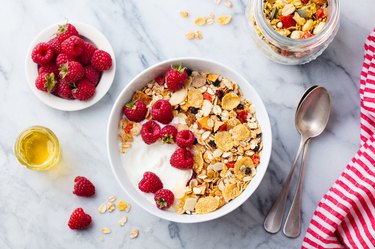
Breakfast cereals are a popular way for many people to start their day. Although cereals are typically fortified with vitamins and minerals, they can also contain a lot of sugar. Whether 10 grams of sugar in your cereal is a lot depends on the rest of your daily diet.
Tip
Consider your overall daily diet when deciding whether or not 10 grams of sugar in a serving of cereal is a lot.
Video of the Day
Video of the Day
10 Grams of Sugar
It might be difficult to imagine what 10 grams of sugar looks like. To help, convert grams to teaspoons. According to Michigan State University, four grams of sugar is equal to one teaspoon. This means that each serving of cereal containing 10 grams of sugar has 2.4 teaspoons' worth.
Sugar doesn't provide any nutritional value. According to the USDA's FoodData Central, one teaspoon of granulated sugar provides 15 calories, so 10 grams of sugar contributes 36 calories to your serving of cereal.
Adding milk to your cereal increases the sugar content of your meal. According to the USDA, 1 cup of whole milk contains 12 grams of sugar. Skim milk might remove its fat content, but 1 cup of skim milk still contains 12 grams of sugar.
Read more: Healthy Cereals With No Sugar
Consider Your Daily Intake
According to the 2015-2020 Dietary Guidelines for Americans from the U.S. Department of Health and Human Services, added sugars — including those in cereal — make up more than 13 percent of the calories consumed per day by people living in the United States.
Official recommendations state that added sugars should make up no more than 10 percent of a person's daily calories. This is equivalent to about 12 teaspoons.
The biggest contributors to sugar in the American diet are sugar-sweetened beverages, snacks and sweets. As the guidelines point out, these foods tend to be higher in calories and provide little or no essential vitamins and minerals needed for a healthy diet. Many cereals fall under this description as well.
However, the guidelines also state that although they contain a small amount of added sugars, whole grain cereals can be part of a healthy diet — as long as total daily intake of sugar doesn't exceed 10 percent of calories.
Try These Alternatives
If you're looking to reduce the amount of sugar in your first meal of the day, consider some healthier alternatives. A 1/2 cup serving of whole grain oats contains 0 grams of sugar.
But, if you need a touch of sweetness, consider adding some fruit or a small amount of honey or maple syrup. Add 1/4 cup of blueberries for only 3 grams of sugar, 1 teaspoon of honey for 5.7 grams of sugar or 1 teaspoon of maple syrup for 4.4 grams of sugar.
If you still want cereal, consider choosing one that's low in sugar. For example, plain Cheerios have only 1.2 grams of sugar in a one-cup serving, while plain Corn Flakes clock in at only 2 grams of sugar in 1 cup.
- Michigan State University: "How to Convert Grams of Sugar Into Teaspoons"
- USDA FoodData Central: "Granulated Sugar"
- USDA FoodData Central: "Whole Milk"
- USDA FoodData Central: "Skim Milk"
- U.S. Department of Health and Human Services: "2015-2020 Dietary Guidelines for Americans"
- USDA FoodData Central: "Whole Grain Oats"
- USDA FoodData Central: "Blueberries"
- USDA FoodData Central: "Honey"
- USDA FoodData Central: "Maple Syrup"
- USDA FoodData Central: "Cheerios"
- USDA FoodData Central: "Corn Flakes"